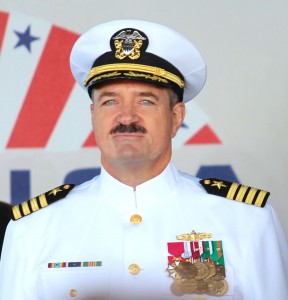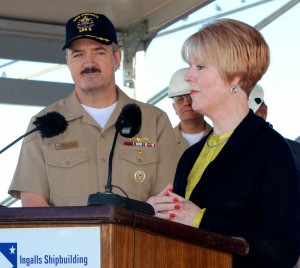2012-11-03 In a four-part follow up set of interviews, Second Line of Defense is looking at the role and impact of the USS America.
Interviews have been conducted with the prospective commander of the ship, the head of amphibious ship building in the USN, a senior USMC general on its role, and, finally, with the Deputy Commander, of the 2nd Expeditionary Strike Group, the role of the USS America as a flagship for an ESG is discussed.
Each interview has allowed us to focus on different aspects of the process of change associated with the ship.
- With Captain Hall we were able to focus on the integration of different capabilities aboard the ship.
- With Captain Mercer, the head of amphibious ship building in the USN, we were able focus on the intersection between those capabilities and innovation in the fleet.
- With Major General Walsh, Deputy Commanding General of the USMC Combat Development Command, we focused on how the ship provides an important impulse to the USMC approach to the future.
- And with Col. Bradley Weisz, Deputy Commander of 2nd Expeditionary Strike Group, we focused on the role of the USS America as a potential flagship for an ESG.
Second Line of Defense visited the Ingalls shipyard in Pascagoula, Mississippi for the christening of the USS America. During the visit, we had a chance to talk with Captain Robert Hall, Jr., the prospective commanding officer of the ship. We were able to follow up that discussion with a longer interview.

During the Christening of the USS America, the Commandant of the USMC, General Amos, turned to Captain Hall and noted that all of the older officers on the podium would love to have his job. And a large part of the reason for this is rather simple: this warship is bringing together three revolutions at once: the Osprey revolution with the F-35 “flying combat revolution” with a new generation of large deck amphibious ships.
And as the ship’s sponsor put it succinctly to the crew of the former USS America: “I know you would love the name to go to an aircraft carrier, but this ship is a mini-aircraft carrier.” And so the Captain is preparing the command approach for this mini-aircraft carrier.
The Captain is an experienced CRUDES officer. For those of us not raised in the USN, this means an officer with Cruiser-Destroyer surface fleet background. And for Navy folks he would be described as a “black shoe” as opposed to a “brown shoe.” Again for those of us who have not served in the USN this refers coming from the surface ship community rather than the aviation community.
He has served as the chief engineer on a Spruance class destroyer and most recently was a Captain of a DDG. And in his last deployment with the DDG, he deployed with the USS Kearsarge as well in the Indian Ocean.
It is important to remember that Admiral Halsey, when he went into the hospital before the Battle of Midway recommended that his surface ship Commander (a “black shoe” in Navy parlance) Admiral Spruance take command of Task Force 16, the USS Enterprise and USS Hornet battle group. Admiral Nimitz CINCPAC, a submariner, accepted Halsey’s recommendation. He leaned on the ability of Spruance to maneuver the ships, to attack and withdraw as a key element of operational dominance. We are seeing once again a merging of the communities.
SLD: How would you describe the USS America?
Captain Hall: The USS America is a warship. It’s an amphibious class ship, but it’s a warship like any other and so mixing the communities together brings some core strengths together. I’ll have a lot of amphibious experience on the America with my crew and my expertise in the surface navy will help us to integrate much better as a team.
SLD: What are some of the core capabilities of the ship?
Captain Hall: We are a large deck amphibious ship, just as the Kearsarge. But we are an aviation-centric large deck amphibious ship and we’ve been designed specifically without a well deck so we can support the USMC’s next generation of aircraft.
We can get out there with a much larger hanger bay with two high-hat areas to support maintenance on the much larger MV-22s. The maintenance requirements for the F-35 are met and we have the capability to expand when required for future development. With our added fuel, ordnance, maintenance capability, supply and support capacity, we can sustain the aviation capability much longer on station.

SLD: And as the first ship deploying with the Ospreys and F-35s in combination you will shape a number of lessons learned important to the rest of the fleet.
Captain Hall: Without a doubt being first of its class and in full support of these next generation of aircraft is an important step. I think we’ll be sharing lessons learned with every potential platform.
SLD: What is the process moving forward?
Captain Hall: The next few months, we’re continuing the building process, and then diving into the test and trials phase. We are expecting the Builder’s trials probably towards the end of July and then Acceptance trials approximately 8-10 weeks after that. Right now it’s looking like early FY14 for ship custody transfer and certification. After that we commission and transfer to the fleet.
SLD: The ship is built to evolve over time with growth capabilities?
Captain Hall: We are configured to grow. We have excess space and six large generators onboard for power generation.
SLD: It must be exciting to be bringing together the new ship design, with the Ospreys and the F-35s into a new operational capability?
Captain Hall: It is. Matching the three together will provide the USN-USMC team with an incredibly versatile and potent force multiplier. Highlighting the awesome capabilities of America is something we need to do moving forward as we continue to fine-tune her concept of operations.
An Historical Note:
Admiral Spruance was one of the best Admirals to ever serve in US Navy.
From his chair aboard the flagship USS Enterprise, Spruance directed the fighting of Task Force 16, made up of the USS Enterprise, the USS Hornet and supporting vessels, large and small.
Prior to the Battle of Midway, Spruance commanded Cruiser Division 5, which belonged to the USS Enterprise’s carrier group.
That’s the role Spruance would probably have continued playing during the Battle of Midway had fate not stepped in and elevated him to the center seat of Task Force 16 aboard the USS Enterprise.
Adm. William Halsey was supposed to be in command of Task Force 16, but ended up confined to sickbay in Hawaii after developing a debilitating skin condition. Unable to direct the task force, Halsey picked Spruance as his replacement, seeing Spruance as a confidence-inspiring leader who had a canny knack for knowing when to take a gamble and when to exercise great caution.
History proves the correctness of Halsey’s choice.
http://www.theussenterprise.com/raymond-ames-spruance.html
Comment by Captain Hall on our historical note:
Admiral Nimitz must have placed a great deal of trust in Admiral Halsey himself to take such a risk on his recommendation. I read that Admiral Halsey actually turned over command of a destroyer to Admiral Spruance many years before they worked together in the ENTERPRISE task force. I guess they must have known each other pretty well and I would imagine Admiral Spruance knew he could rely on the professionalism and carrier expertise of Admiral Halsey’s staff that he would inherit. Besides the great story of the Midway battle itself, the circumstances surrounding all the decisions made before and during the battle provide some extraordinary examples of great leadership.

